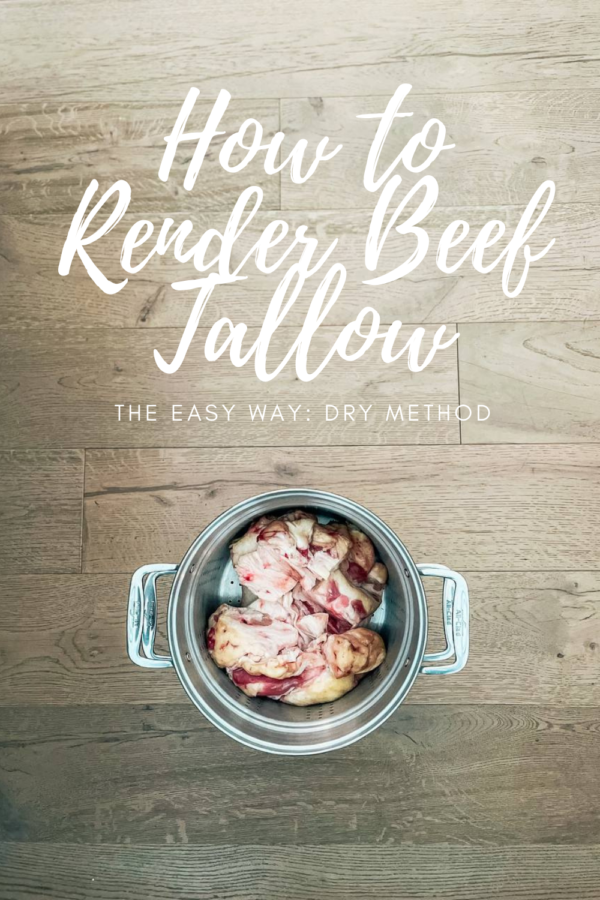What is Beef Tallow? Includes Recipe for Rendering Tallow!

This post has been updated as of March 2022.
In short, beef tallow is a rendered cooking fat made from the fat from a cow. Yes—beef fat. But saturated fat is awful right? There are many posts out there which explain why saturated fats are actually healthy (see this video which debunks the saturated fat myth in 2:35) so this post isn’t going to be about that. You can read more about whether saturated fat is healthy here. This post is going to be about flavor and texture. Now that we don’t use vegetable oil for high heat cooking at home, I notice the smell of it. It has a very distinct aroma that doesn’t agree with me. And, when I eat these kinds of oils when I am out at a restaurant, I end up with a tight chest and a raspy cough reminiscent of my asthma attacks. Thankfully I don’t get a full blown asthma attack anymore but I avoid them all the same. The fact of the matter is, vegetable oils (corn, soy, canola) are most likely genetically modified and are highly refined with deodorizers added to cover up what would be a very rancid smell. I can now detect this rancid aroma and frankly it sets off alarm bells in my body.
I wanted to find a fat to use for frying and I would recommend coconut or palm oil but this can get pricey. To fry a batch of French fries you need quite a bit of oil. I thought about using schmaltz or chicken fat which I skim from the top of the chicken soup I make. But that just gives me a small amount. I wanted to get my hands on a large amount of fat for frying French fries and other items and I only had to look as far as my local dairy farm. I saw that they sold beef fat in 5 pound bags and that I could render this beef fat into tallow to use for frying. I was thrilled but also a bit apprehensive. How did I do this thing called ‘rendering’ and what if I messed it up? There were many different methods – wet and dry and in the end, I chose the method that seemed like it would be the easiest to clean up after – the wet method. We were pleasantly surprised after using beef tallow for frying. The fried items came out crispier and surprisingly light. They didn’t soak up the oil and fried up easily.
How to Render Beef Tallow
Wet Method
Ingredients
- 5 pounds of beef fat and trimmings
- Water (see below for amount)
Directions
Take a nice sized pot and fill about 2″ of water in the bottom of the pot. Place the entire 5 pounds of fat into the pot and let it melt down on high heat. Turn the heat down to med/high when the melted fat starts to bubble. Turn down the heat the lowest temperature you can while keeping the melted fat at a low simmer. After a few hours the water will evaporate leaving you with beautiful golden oil.
Dry Method (my new updated fave!)
Ingredients
- 5-10 pounds of beef fat and trimmings
Directions
Grab a large stock pot or soup pot and put fat inside the pot using a steamer insert. I actually have a pasta insert which has a lot of holes in it like this one.
Place the stock pot with the insert and the fat into the oven set at 220 degrees Fahrenheit. It can take up to 10-14 hours to render a lot of fat so start early or do it overnight. Let all the fat render until you are just left with some cracklins. I use a potato masher to mash the fat down a few times while it is rendering to help release all the fat.
For either method – Take a stainless steel bowl, set a stainless steel colander on it, line with butter muslin or cheese cloth and pour the hot oil through, being super careful not to burn yourself. The muslin will catch the fine particles of meat.
I like to pour this rendered oil into silicon ice cube trays. Put the trays in the fridge overnight and when cool, pop out the cubes of tallow and store in plastic containers in the freezer. I keep one container in the refrigerator of lard/tallow for cooking.
I will leave you with this…
Did you know that McDonald’s French Fries used to be fried in beef tallow up until 1990 when they switch to a partially hydrogenated vegetable oil? So they used to actually be somewhat healthy! Now they are just limp and tasteless to me.
How about you? Have you ever tried this before? Tallow is truly amazing to roast potatoes in!
This post is featured on Fat Tuesday, Traditional Tuesday, Real Food Wednesday, Fill Those Jars Friday, Small Footprint Fridays

Thanks so much for this! I’ve seen this everywhere and wondered what it meant to “render”! I don’t make very many fried foods for the exact reason you listed- coconut oil ain’t cheap! This helps. I can totally do this.
On another note, thanks for doing the giveaway. To do that out of your own money is quite impressive. I’m not in the Austin area (would LOVE to live down there) and sometimes I feel like I’m on an island in a fake food sea. So thanks for being a fellow Texas keepin it real(foods)!
Visiting from VGN. Just pinned and facebook shared you SMLL posts!
Thanks Momma!
We are BIG consumers of both beef tallow and pork lark here. We raise our own pork and plan to raise our own beef soon. A really easy and quick way to render your suet/tallow/lard etc is to place in your ever so handy crock pot with about 1/4 cup of water and place on high. it renders away. I stir it up about every 20-30 mins in the beginning so that nothing sticks. You can save the cracklings and eat them if you like. I then strain through a metal strainer into a jar but there are many options. We use our render tallow for everything from pastries to lotion. Its amazing lotion!
That is a great idea Leah – I will have to try that!
I have a big thing of beef suet in my freezer I bought from my milk farmer. He had listed ‘beef tallow’ on the order form but it was the suet that needs to be rendered. This post has inspired me to give it a go! What a great use of the silicone trays too! Thanks for posting this!
I’m not sure where to find 5 pounds of beef fat. Is this sold in the grocery store or would it be better to ask at the farmer’s market?
^ where did you buy your beef fat?
I was told by a local dairy that the fat around the heart and kidney are the best and also buy fat from cows that have not been fed antibiotics and hormones. We have a butchering house here that raise their own cattle and are grass fed.
I would like to do this (render fat) to make food for the wild birds by adding bird seeds,etc. Just wondering, is the rendering the lard/fat/tallow via the wet method a smelly process? I don’t like the idea of having a really smelly house. thanks.
I don’t remember it being too bad.
Hey Lindsey, thanks for your post! I have a question though, do you think an ice cube tray will work also? And where is it best to store the jar after rendering it? Thanks so much!
I think that could work just fine. I store mine in the freezer.
I often make bone broth from beef bones. After cooling the broth in the fridge, I separate out the beef fat to make tallow. This way I get to enjoy both the broth and the tallow! Love the clip from Julia Child! She’s so classic. Even in 1995, she knew the benefits of saturated animal fat.
After you use the tallow to fry french fries etc. with is it necessary to put it back in the refrigerator until the next use. with other oils you dont so i was wondering before i tried it how to store it after use? thanks
Could you use lard that is sold at the store?
This isn’t a recipe for lard. It is a recipe for beef tallow.